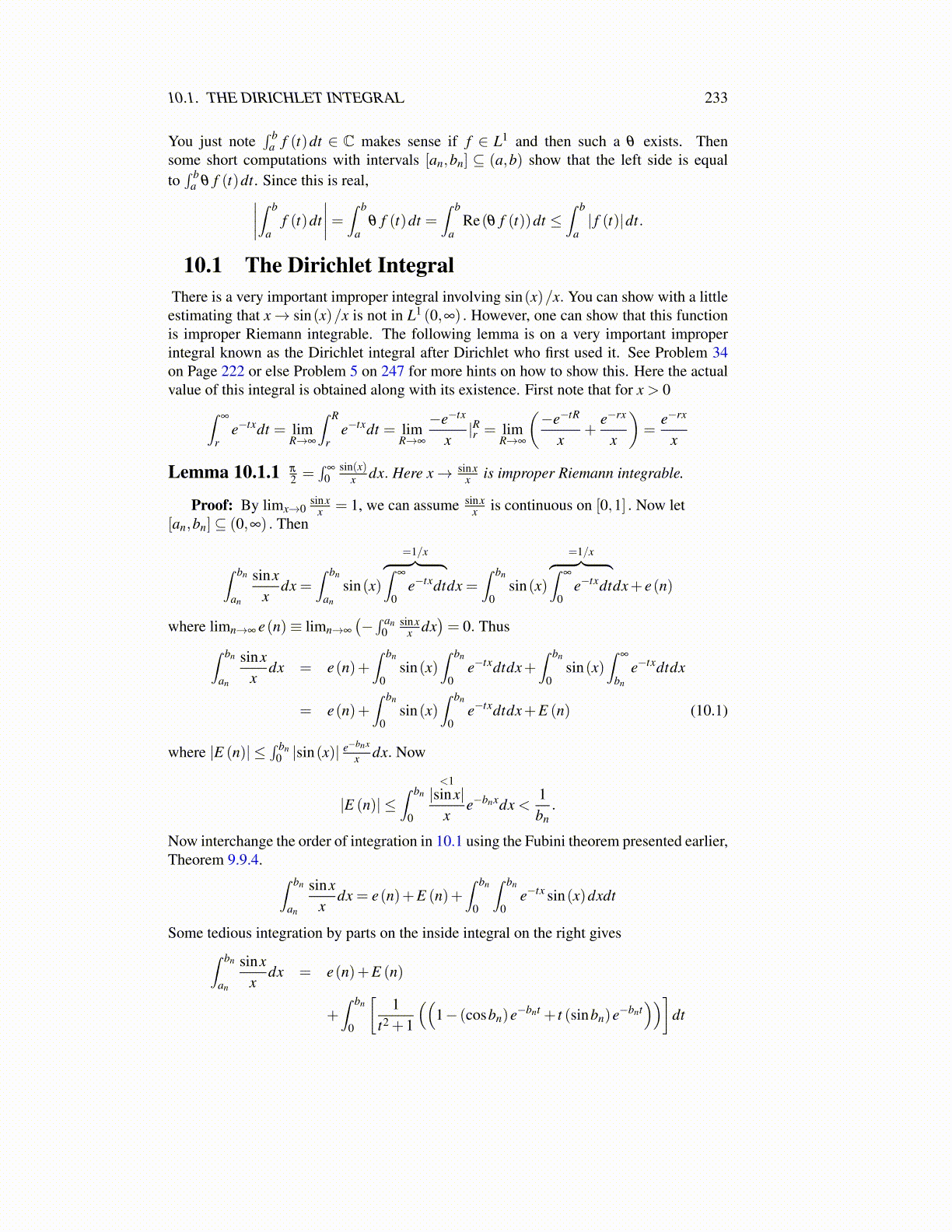
10.1. THE DIRICHLET INTEGRAL 233
In general, you break down f . f (x) = | f (x)|+ f (x)2 − | f (x)|− f (x)
2 ≡ f+− f− where both f+ andf− are nonnegative functions. These are both integrable thanks to Theorem 9.3.13. Thenlet s+ ≤ f+,s− ≤ f− with
∫ ba ( f+− s+)dx,
∫ ba ( f−− s−)dx both less than ε/2. Then letting
s = s+− s−, it is also a step function and∫ b
a| f − s|dx =
∫ b
a|( f+− f−)− (s+− s−)|dx =
∫ b
a|( f+− s+)+(s−− f−)|dx
≤∫ b
a| f+− s+|dx+
∫ b
a| f−− s−|dx <
ε
2+
ε
2= ε
In addition to this,
|s(x)|= |s+ (x)− s− (x)| ≤ s+ (x)+ s− (x)≤ f+ (x)+ f− (x) = | f (x)| .
This takes care of the case where f is real. If it is complex valued, then to say it is Riemannintegrable means simply that the real and imaginary parts are Riemann integrable. Youapply what was just shown to these real and imaginary parts of f .
Now consider the last claim. First let f ≥ 0 and let s be as chosen earlier with s(x) ≤f (x) and
∫ ba | f (x)− s(x)|dx≤ η . Say s(x) = ∑
nk=1 mkXIk (x) where Ik is an interval. Con-
sider the following picture which approximates XIk with a continuous function called hkwhich is zero at the ends of the interval Ik.
α βα +δ β −δ
hδk
Then replace s(x) with ∑nk=1 mkhδ
k (x)≡ hδ (x) . Then hδ is a continuous function whichequals zero at a,b. Also,
∫ ba
∣∣s(x)−hδ (x)∣∣dx < η if δ is small enough. (Why?). Then let
δ be this small and denote the resulting function by h. Thus for M an upper bound tosup{| f (x)−h(x)| : x ∈ [a,b]} ,∫ b
a| f (x)−h(x)|2 dx ≤ M
∫ b
a| f (x)−h(x)|dx
≤ M(∫ b
a| f (x)− s(x)|+ |s(x)−h(x)|dx
)≤ 2Mη
Since η is arbitrary, this proves the second assertion in the case that f ≥ 0. To get theresult in general, do what was done in the first part. Let f = f+− f− where these twofunctions are nonnegative and Riemann integrable thanks to Theorem 9.3.13. Let h+ ≤ f+and h− ≤ f− go with f+ and f− respectively as in the above such that∫ b
a| f+ (x)−h+ (x)|2 dx,
∫ b
a| f− (x)−h− (x)|2 dx≤ ε/4
Then for h = h+−h−,∫ b
a | f −h|2 dx =∫ b
a | f+− f−− (h+−h−)|2 dx
≤∫ b
a(| f+−h+|+ | f−−h−|)2 dx≤ 2
∫ b
a
(| f+−h+|2 + | f−−h−|2
)dx
≤ 4(ε/4) = ε
and since ε is arbitrary, this yields continuous h, zero at end points such that |h| ≤ | f |as before. In case f has complex values, apply this that was just shown to the real andimaginary parts as was just done.